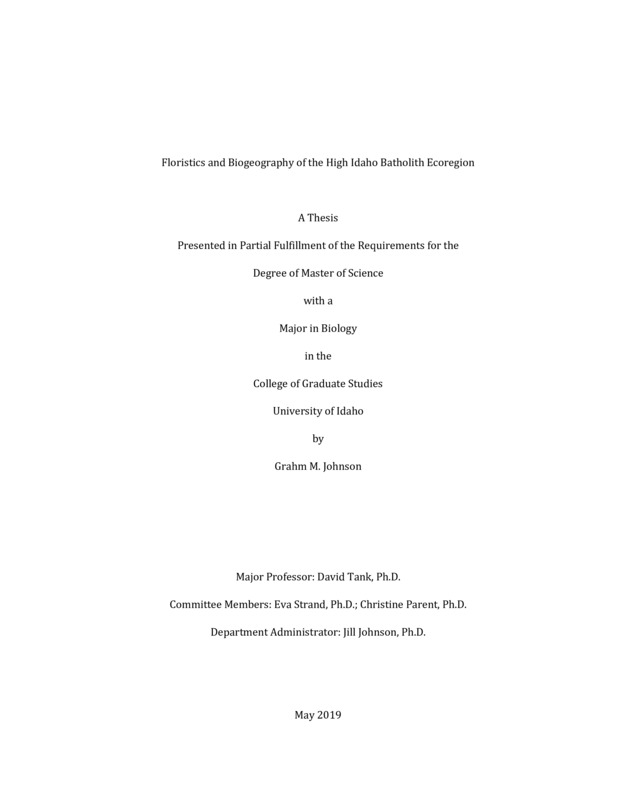Floristics and Biogeography of the High Idaho Batholith Ecoregion
Johnson, Grahm Michael. (2019-05). Floristics and Biogeography of the High Idaho Batholith Ecoregion. Theses and Dissertations Collection, University of Idaho Library Digital Collections. https://www.lib.uidaho.edu/digital/etd/items/johnson_idaho_0089n_11510.html
- Title:
- Floristics and Biogeography of the High Idaho Batholith Ecoregion
- Author:
- Johnson, Grahm Michael
- Date:
- 2019-05
- Program:
- Biology
- Subject Category:
- Botany; Biology
- Abstract:
-
Chapter 1:
This inventory expands the floristic knowledge of the disparate, subalpine-alpine mountain ranges of the High Idaho Batholith Ecoregion (HIBE), a notably under-collected region in the interior Pacific Northwest (Consortium of the Pacific Northwest Herbaria, 2007). Located in central Idaho, the 3,295 sq km (1,272 sq mi) ecoregion spans eight national forests and ranges in elevation from 1830-3350 m (6,000-11,000 ft)(McGrath et al., 2002; Woods et al. 2002). The HIBE was surveyed for all vascular plants within the top 152 m (500 ft) of elevation for targeted peaks, with permanent voucher specimens taken and housed at the University of Idaho Stillinger Herbarium, Moscow, Idaho. Over four summers, 1,302 numbered specimens were collected from 20 different peaks, with 47 families, 175 genera, 310 species, and 414 unique taxa represented. Also, six species of conservation concern were found on 19 peaks, and 12 collections represented new county records. Remarkably, only two exotics from one locality were documented. In addition, formal description of a new variety, Montia parvifolia var. batholica, which was collected at three localities, is the subject of ongoing work (unpubl. data).
Chapter 2:
Although alpine ecosystems are the only globally distributed terrestrial biome, they represent one of the largest remaining gaps in floristic knowledge, making accurate predictions of the impacts of climate change difficult. In this study, we investigated community composition of the subalpine and alpine restricted flora from 20 peaks across the High Idaho Batholith Ecoregion (HIBE) of central Idaho in light of both abiotic (temperature, precipitation, ruggedness) and biotic (species-specific functional traits) variables. Non-metric multidimensional scaling and clustering analyses supported three, geographically distinct floristic groups within the ecoregion. Furthermore, environmental and species-specific trait data revealed a correlation between the three floristic groups and a gradient of increasingly harsh and heterogeneous alpine habitat from the northwest to the southeast across the ecoregion, suggesting a strong environmental filter. With this framework, it may be possible to incorporate knowledge of floristic patterns, hypotheses of climatic resiliency with respect to landscape ruggedness, and our floristic knowledge gaps into land management decision-making processes
- Description:
- masters, M.S., Biology -- University of Idaho - College of Graduate Studies, 2019-05
- Major Professor:
- Tank, Dave C.
- Committee:
- Strand, Eva K.; Parent, Christine E.
- Defense Date:
- 2019-05
- Identifier:
- Johnson_idaho_0089N_11510
- Type:
- Text
- Format Original:
- Format:
- application/pdf
- Rights:
- In Copyright - Educational Use Permitted. For more information, please contact University of Idaho Library Special Collections and Archives Department at libspec@uidaho.edu.
- Standardized Rights:
- http://rightsstatements.org/vocab/InC-EDU/1.0/

